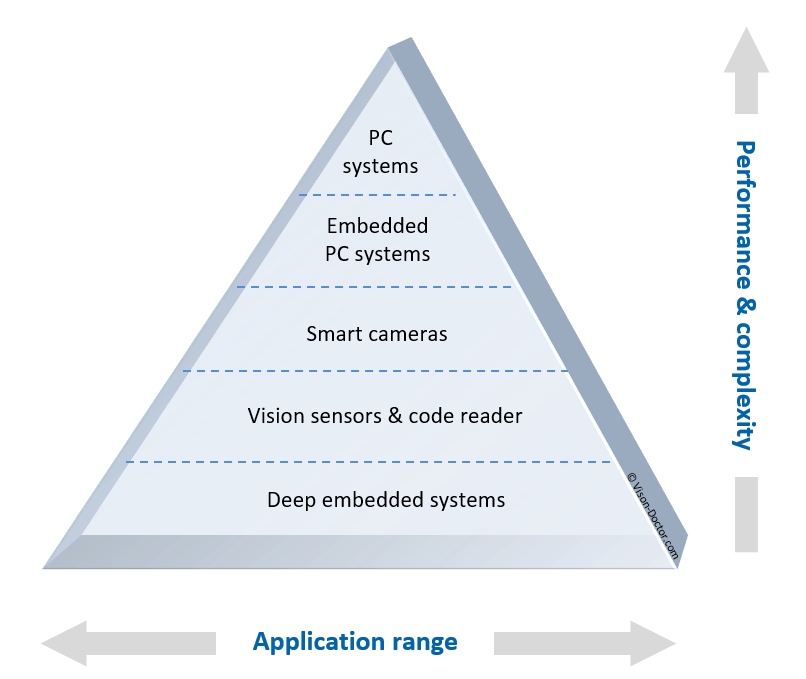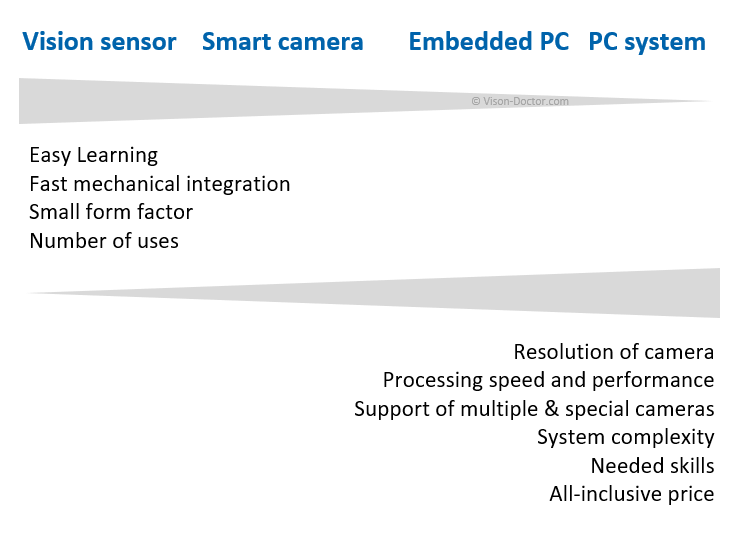System Selection
The flood of individual image processing components to compile your own system is hardly manageable and also the number of manufactures of intelligent camera systems grows from year to year. Due to the increasing capacity of digital signal processors (DSPs), very cheap and clearly more compact systems can be realised with little hardware expenditure, which would have required a more complex system in the past.
 |
Simple vision sensors and code-readers find a ready market in automation. This is caused by the price decline of electronic components and the easy operability. Integration costs are low, prices for this devices range from a few hundred to about 1500 dollars.
More complex intelligent camera systems, also called smart cameras
The hardware familiy of embedded systems, like the classic PC-based systems, mainly works with cameras for the image acquisition and a central processing unit. This can now also be proprietary hardware or an embedded PC system working with Windows CE, Windows Embedded or Linux. The advantage of these solutions is the higher processing capacity due to a separate central unit which can be clearly larger than a smart camera. If more computing capacity and/or a multi-camera solution is required, these fanless units will be the first choice. These more complex solutions are often used by more advanced users and systems traders.
The traditional PC-based image processing system offers the highest flexibility. By freely selecting the PC and machine vision hardware, such as processors, frame grabbers, cameras, interface cards, hard drives and RAM, a system can individually be put together with a good price-performance ratio. The basic investment, however, is several thousand euros which can hardly be deceeded. However, when faster, higher-resolution cameras or several cameras are required, this system will be cheaper. The machine vision software used may range from completed graphic user interfaces easy to operate to freely programmable special solutions on the basis of software libraries. When data and images must be documented and archived and an individual user interface is required, there is no way around a PC-based system. For systems traders who offer and sell solutions for applications, this will be the ideal system.
Which image processing system should I use?
- How complex are the hardware requirements? A smart camera is indeed easier to handle, but will it provide a proper solution? Is a simple graphical user interface sufficient or must I program my own application?
- Do I have the necessary technical resources and expertise to plan, develop, operate and support the system myself or should it be a purchased complete system?
- Do I have enough time to handle the project?
- Should the machine operator be able to program new product variations and applications? Possibly an intelligent camera system is advantageous here which, however, cannot fulfil all tasks but are easier to handle. Setting simple process parameters can be more elegant using PC-based systems, as the user interface has often been individually adapted to the requirements by the systems trader or the internal machine vision department of the company.
- How important is the price of the system to me? Do I look for a good allround solution for as many different create-your-own tasks as possible or a special high-end system? Simple intelligent systems are clearly financially advantageous in case of simple inspection tasks and low resolutions, as no complete computer system is required. From two or more cameras on and higher resolutions, the PC system is increasingly attractive in terms of price.
- Do I have programming skills? Both for PC and intelligent cameras there is software with a completed graphical user interface or it can be created individually using compilers and specially adapt it to the customer requirements.
 |
- How easyis it to operate and maintain the system? Please consider not only the primary investment, but also maintenance in everyday life.
- What technical support do I get from my supplier or partner? How long is the delivery time or reaction time in case of trouble?
- Is your partner a newcomer or existing already for many years? Will this company still exist in future?
Further details can be found atchapter return on investment.







